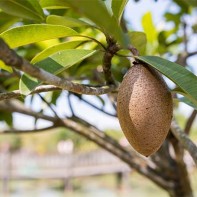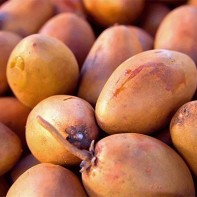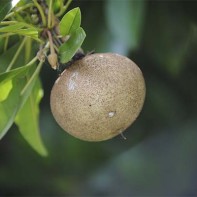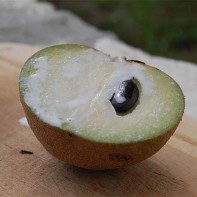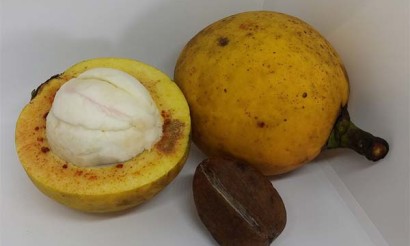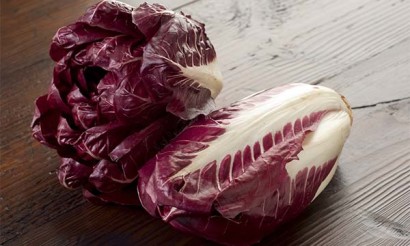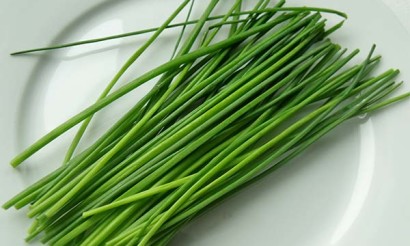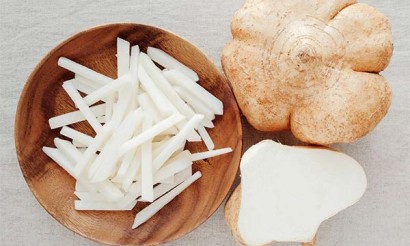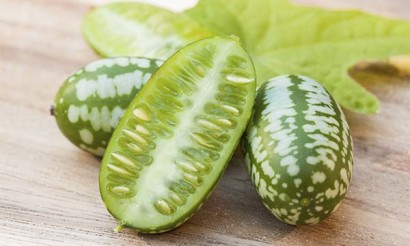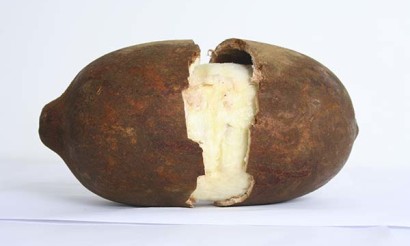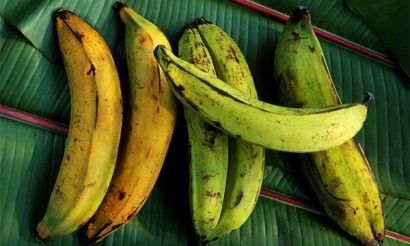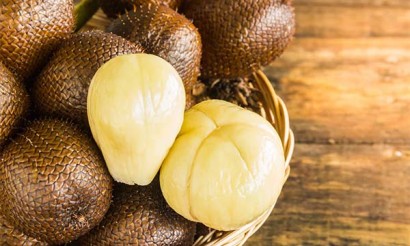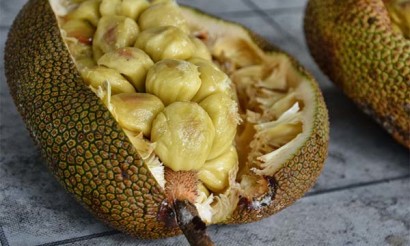Sapodilla: what is this fruit and why is it useful?
Sapodilla (another name - lamut) grows in warm climates. This fruit is somewhat exotic for our edges. Many people have not even heard of this fruit and do not know what it looks like. These people miss a lot, because the vast majority fall in love with this delicate taste and soft texture after the first tasting. Of course, it's important to get the ripe sapodilla.
- What kind of fruit is it
- Where it grows
- The composition of
- What is the usefulness of the sapodilla fruit
- What harm it can do
- How to eat sapodilla properly
- What you can make with sapodilla
- Salad
- Fritters
- Jam
- Pickled sapodilla
- Traditional medicinal uses
- Industrial and Cosmetic Applications
- How to choose the right fruit
- How to grow sapodilla
- Interesting Facts
What is the fruit
The sapodilla is the fruit of the eponymous evergreen tree of the sapodilla family. The tree can reach a length of up to 30 meters, and the substances in its trunk produce rubber and the base of chewing gum.
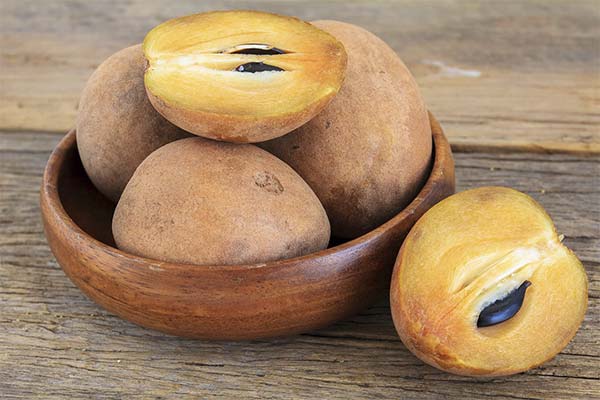
The fruit itself reaches 10-15 cm in diameter and is round or oval in shape. It has a thin brown peel on the outside and a soft yellow or orange flesh and small stone inside. The peeled fruit looks a bit like a potato.
The taste of the fruit can be compared to persimmons or pears. The unripe fruit has astringent properties. A ripe sapodilla should be sweet and moderately soft. The overripe fruit becomes luscious.
Where does it grow?
The fruit is native to southern Mexico. It was later cultivated in India, Pakistan, Vietnam, Malaysia, the American tropics, Sri Lanka and the Philippine Islands.
The perennial tree bears fruit once a year, but the timing of the harvest varies from region to region, making the sapodilla fruit available year-round.
Composition
Sapodilla fruit has 83 kcal per 100 g of flesh. The fruit has absolutely no cholesterol. Also in its chemical composition can be found:
- 1.1 g of fats;
- 20 g carbohydrates;
- 0.4 g protein;
- 5 g of dietary fiber.
As for the amount of vitamins and minerals per 100 g, the picture is as follows:
- 193 mg sodium;
- 12 mg of potassium;
- 21 mg calcium;
- 14.7 mg of vitamin C;
- 12 mg magnesium;
- 0.8 mg iron;
- 60 IU of vitamin A.
How is the sapodilla fruit useful?

- The fruit is high in glucose and carbohydrates, making it a high-energy product. It's the perfect fresh breakfast before a day at work and a snack for athletes.
- Rich in vitamins and minerals, the fruit strengthens the immune system. Regular eating of sapodilla is good for skin, nails and hair. A large amount of natural latex, calcium, tannin, and vegetable fiber make chewing sapodilla very beneficial for the teeth and oral hygiene.
- This fruit is a vitamin bomb for pregnant and nursing women due to its high carbohydrate and micronutrient content.
- The use of this fruit has a beneficial effect on the nervous system, helps to become calmer and more stress-resistant.
- Vitamin A promotes that the vision was always in order.
- Potassium and magnesium are recommended for people suffering from hypertension, so delicious sapodilla will have a beneficial effect on them.
- It increases hemoglobin levels and improves iron absorption.
- One or more fruits can be eaten if diarrhea occurs. Preferably, they should be slightly immature, then their strengthening properties will be at their best.
- The substances in the pulp help to normalize the work of the secretory gland of the stomach. This helps to improve digestion and stabilize weight.
- This fruit has diuretic properties and helps to remove kidney stones.
- Lamut is also valued for its anti-inflammatory and anti-fungal properties. It will be useful to eat it when the immune system is weakened, viral and colds.
- Antioxidants and retinol, which are in the fruit, can counteract cancer cells. Thus, regular consumption of fruit or fresh juice can prevent cancer.
What harm can come from
Exotic fruits can cause allergic reactions, so you should not eat large amounts of these fruits at once. It is better to consume 2-3 fruits first and make sure that the body is okay.
As such, there are no contraindications, but should be used with caution in such situations:
- Diabetes mellitus. Since the fruit contains a lot of sugar, people with diabetes or prone to it should be careful not to provoke an attack.
- When you are struggling with overweight or prone to obesity. This fruit has a high caloric value.
- You should not use lamut if you have an individual intolerance. In the risk group are all those who face allergic reactions when eating apples, bananas, kiwi, tangerines and oranges. All newcomers are advised to be cautious and start consuming the fruit in small doses.
- It is worth excluding sapodilla from the diet of children under three years to avoid allergic reactions.
It is not worth piling on the lamut if you are not sure about its maturity.
How to eat sapodilla properly
If the fruit is really ripe, you can eat it like an avocado: cut it in half, take out the pips and extract the pulp with a teaspoon. You can also remove the inedible rind and just take a bite out of the whole half.
Important! The fruit should be rinsed in warm water before consumption.
What you can make with sapodilla
The delicious pulp of sapodilla is already quite a self-sufficient dessert. It can be flavored with lemon or lime juice.
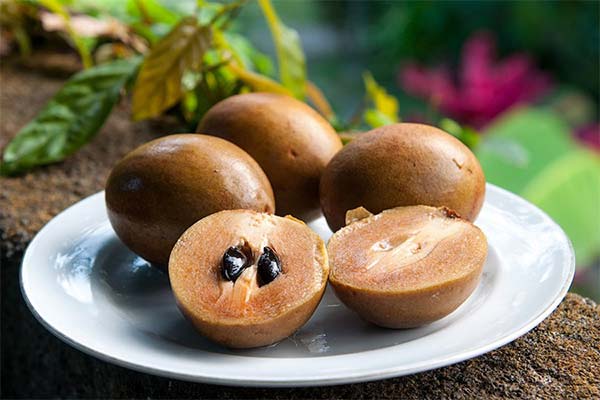
Its main culinary uses are in desserts, yogurts, and smoothies. Jams and compotes are also not bad tasting. In the regions where it grows, one can taste sapodilla wine.
Lamut goes excellently with seafood and even meat! It has an interesting and exquisite taste. It is very easy to make a sauce to go with fish or shrimp, if you grind the pulp in a blender, pour boiling water and boil for 20-30 minutes with spices, salt and sugar to taste.
To prepare one serving of smoothie you will need 1 fruit (200-250 g) and about 50 g of black currant. You can also add honey to taste. All this should be whipped in the bowl of a blender and put in the refrigerator for a few hours.
Salad
To prepare a salad with the addition of sapodilla will need:
- 2 green apples.
- 2 tangerines.
- 3 sapodilla.
- Adygean cheese 120g.
- Lemon juice 3 tablespoons.
- Olive oil 3 tablespoons.
- Wine vinegar 2 tablespoons.
Dice green apples and sapodilla, cut mandarins into wedges. Mix the cheese in a bowl, add the grated cheese, lemon juice, wine vinegar and olive oil.
Fritters
Sapodilla fritters are a great snack for tea or coffee. They can also be served for breakfast or unexpected guests.
5 fruits should be peeled from the skin and pips, and then grated on a fine grater. Then add 200 grams of flour, 1 egg, 3 tbsp. sour cream. Fry in vegetable oil on both sides.
Jam
To make jam, you will need 5 kg of fruit. They need to be peeled and chopped, and then pour 1.5 kg of sugar and leave for an hour and a half. When the juice runs off, you have to crush and mix the fruit. The resulting mass is poured with a mixture of 300 ml of water, 7 tbsp. lemon juice, 3 tbsp. honey, then put on a low fire and simmer for about an hour.
Pickled sapodilla
Both whole and sliced fruits are suitable for pickling. It is not necessary to remove the skin. It is enough just to wash the fruit, pour water over it and let it stand for about two hours.
To prepare the marinade you need to boil 10 liters of water, pour about 2.5 kg of sugar, and a little salt. Soaked fruits are put in a wooden barrel and pour the marinade. Cover the top with a wooden lid and leave under a heavy weight in a room whose temperature does not exceed 18 ° C. In this way the fruit is stored for 2 weeks.
Folk Medicine Applications
Sapodilla is most widely used in folk medicine in the countries where it grows, because it is not easy to get it in the CIS. Here, people would rather enjoy it as a delicacy than use it for treatment.
However, growing the tree at home gives more options. From the leaves and bark can be prepared an antibacterial decoction, which solves problems such as high blood pressure, fever, and intestinal discord.
The pulp or a small piece of pulp can be applied to the burned area of the skin - this will promote healing. Also the pulp of the fruit is excellent against dry skin, eczema, fungal growths.
Industrial and cosmetic uses
From sapodilla wood, specialists extract the so-called milky latex on an industrial scale, and from it, in turn, they already produce chicle and rubber. By the way, previously chicle was used in the production of chewing gum, because it added to the viscosity of this product. At the moment, it is almost never used for this purpose, it has been replaced by synthetic bases.
Once every three years is collected from the plant milky sap. For this purpose, special deep incisions are made on the bark. This is similar to the collection of birch sap that we are accustomed to. Vessels are placed to the incisions, designed to collect the liquid, which almost immediately thickens. Once collected, the sap is transported directly to the processing plant.
Even oil is squeezed from the seeds of this plant, which is then widely used in cosmetology and even for medical purposes. Good for problematic skin, the oil helps in the fight against inflammation, effective for dermatitis. As for its use in cosmetology, this product is added to shampoos, masks, massages, as well as to balms and even perfumes.
One cosmetic recipe that is available at home: mix sapodilla and burdock oil in equal proportions. Add honey, heavy cream and egg yolk to make our mask more nourishing. Spread on your scalp and cover with a compress on top for 20 minutes. The recipe is good for moisturizing and nourishing the skin.
How to choose the right fruit
This exotic fruit is almost not transportable, so it is very difficult to find it in Russian and Ukrainian supermarkets. The ripe fruit is stored in the refrigerator not more than a week, and in warmth - 2-3 days. When the fruit goes bad, its smell and taste becomes unpleasant, and then it begins to rot and the fermentation process begins.
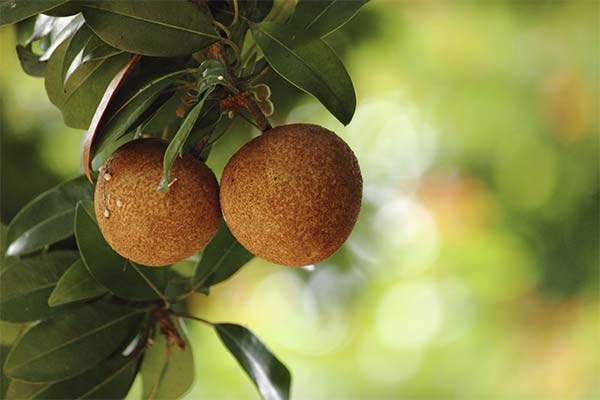
Unripe sapodilla has a fairly high tannin and latex content, so eating such a fruit is not recommended. These substances give the fruit an astringent taste and bitterness. The lamut rarely ripens on its own. That is why you will be able to taste it only in the places where it grows.
If you are in the countries where this fruit grows and decide to buy it, then you should pay attention to the following indicators:
- The rind should tightly cover the fruit.
- There should not be any signs of even partial rot, the surface should be without damage or cracks.
- If when you put pressure on the fruit it is too hard, the fruit is unripe. If it is very soft, it is overripe.
How to grow sapodilla
In cold regions, as you know, the tree will not take root in the open ground at all, but you can still grow it at home.
Seeds are taken out of the fresh fruit and left for a day in warm water, then planted in the soil, which should be moist, but not flooded. This container is placed in the sunniest place. The seedlings should appear in a couple of weeks, and when they are 8-12 cm in height, they again need to be transplanted. A medium sized pot is ideal for this, it will allow the root system to grow sufficiently.
During the flowering period, which will not begin until the 4th or 6th year, you need to help the plant with pollination, passing pollen from one flower to another with a rag glove.
Interesting Facts
- One mature tree can produce up to 3,000 fruits per year.
- Although the plant is native to South America, it is most common in Thailand. By the way, from September to January you can find the fruit there at the lowest price.
- To eliminate diarrhea, you can use not only the unripe fruit, but also the extract from the seeds, preparing a decoction. Also antipyretic and antiseptic decoction is prepared from the bark.
- Another alternative name is wood potato. The names ahra or oil tree fruit can also be encountered. In Latin America, the fruit is better known as chica or chica.
- The sapodilla tree belongs to the sapot family. This genus of evergreen plants and shrubs grows mostly in tropical countries and produces much useful wood and fruit.
«Important: All information on this site is provided for informational purposes only for informational purposes only. Before making any recommendations, please consult your health care professional. health care professional before using any of the information on this site. Neither the editors nor the authors shall be liable for any possible harm caused by materials."

